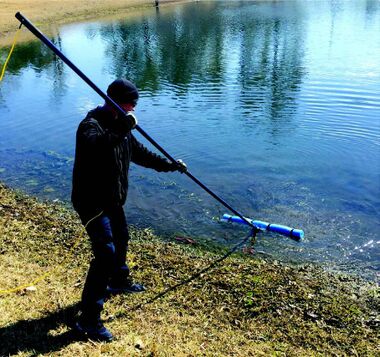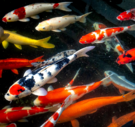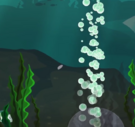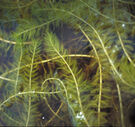
Summer is coming to an end, and with it, a change of seasons is on the horizon. Pond owners need to be aware of the temperatures to ensure the best transition for their ponds and everything living in them. If you are living in a climate that has cold winters and snow it is especially important to prepare your pond for its seasonal transition. Listed below are a few simple tips for you as pond owners to consider in preparing your pond water for winter.
In the fall trees will begin to prepare for winter by shedding their leaves. Plants and crops die off and rains will create run off which brings additional loads of organic matter in to ponds. If your pond is surrounded by trees, crops or other plants you want to reduce the amount of dead leaves and plants that enter the water. Either by trimming trees and brush near the pond to prevent them from falling into the water, or by raking them away before they come in. The more dead matter that enters the pond, the worse off the body of water will be.
Organic matter that comes into the pond will start to decompose and in the process, will deplete needed oxygen from the water that is used for other purposes such as keeping fish alive and ensuring the pond does not become stagnant and smelly. This organic matter will also build up layers of muck and sludge at the bottom of water which leads to higher nutrient levels causing unnecessarily high growth of algae and weeds the following spring and summer.

Ponds and pond life begin to slow down as colder weather sets in. Most of the beneficial bacteria and enzymes applied in the spring and summer that are used to consume excess nutrients in the water have now died off. At this time we suggest you consider adding a blend of bacteria and enzymes that work in colder water temperatures. Nature’s Pond Conditioner Fall/Winter blend is a special blend of naturally occurring bacteria, enzymes, and plant extracts, formulated with a preservative that adds to the longevity and productivity of the bacteria and enzymes through the colder weather conditions. It enables the microbes to keep consuming and cleaning the debris, run off, and decaying matter in your pond throughout the winter months. By doing this you avoid getting that smelly rotten egg odor that starts to occur during the winter and spring. It also helps the water remain clean and clear all winter long thus providing a healthier pond environment for your fish, pets and livestock.
We cannot stress enough the importance of aerating a pond in the winter. Oxygen levels can become fatally low in the winter which can cause harm to the life it supports in the water.
Here is a short timeline of what will happen to your pond if it is not aerated in the winter:
Pond water starting off the spring is ripe for early algae blooms and is of poor quality for other uses such as crop irrigation and cattle drinking. To avoid all the problems that can occur during and after winter the best solution is bottom up aeration. By providing oxygen to the water environment:
Aerated dugouts will typically have an open area of water. This open water is due to the constant circulation of air bubbles rising from the bottom to the surface of the pond body. The amount of open water is determined by the type of diffusers and the overall efficiency of the aeration system. Point source diffusers such as air stones create a lot of turbulence at the surface and help prevent ice formations. The deeper the diffusers are placed in the water column the more efficient the oxygen transfer rate and the larger the size of the hole created in the water.
Another benefit of having open water in the winter may be for watering cattle and other livestock, attracting ducks and other animals to the ponds edge. Hunters appreciate the extra benefit of keeping fish healthy while at the same time attracting ducks, deer, and other animals to their hunting grounds.
If you choose not to aerate your pond for a portion of the winter in order to have the pond freeze over for skating and activities, you can protect wear and tear on your windmill compressor by lowering it down using your pivot point tower hinges.
Freezing can cause damage, wear and tear on aeration systems. If you are in a colder climate then we recommend attaching the Koenders Freeze Control Unit. Whenever you compress air condensation can form in the airline and can create an ice blockage if it is cold. With a freeze control unit alcohol will be automatically be injected to melt the ice. This will help ensure aeration during winter as well as help protect the compressor from backpressure due to blockages. We recommend using Isopropyl Alcohol at 90-99% purity.
For Koenders customers in colder climates we also recommend a pressure release valve and weighted airlines. A pressure release valve will protect your compressor from backpressure due to line blockages like ice buildup or a twisted hose. Eliminating backpressure will increase the lifespan of your unit. It is recommended to use weighted airlines in the water so that it does not float in your pond. This will help prevent lines freezing in the ice layer on top of the pond and cracking. 
This blog discusses pond issues and solutions for Homeowner Associations.

This blog discusses the history of koi, tips and care suggestions, and how to keep a koi pond clean and clear.

Aeration Systems and the Benefits of Bottom UP Aeration…
A quick look at how Nature's Pond Conditioner works for your pond!

What is an Ecosystem? “An ecosystem is a geographic…